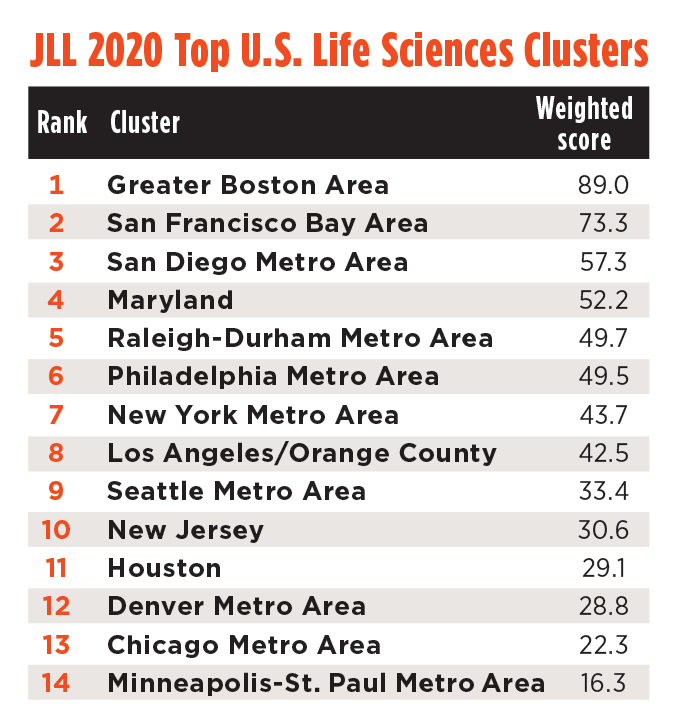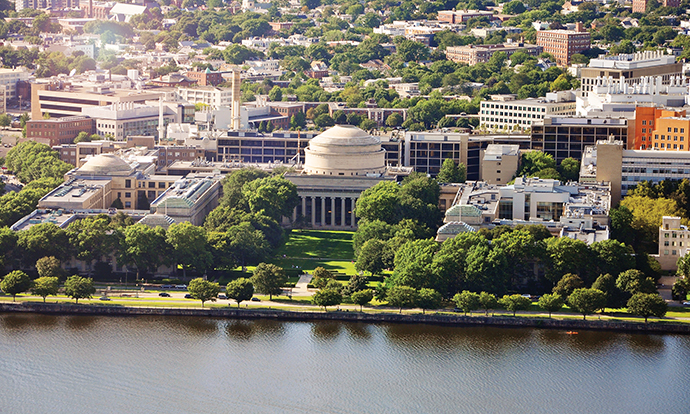JLL in late July released its 2020 U.S. Life Sciences Outlook, including the firm’s annual cluster ranking based on employment and firm concentration, venture capital and NIH funding, lab supply and market occupancy rate.
Surprise: Boston, San Francisco and San Diego rank Nos. 1, 2 and 3, with VC funding a big reason why. Those three ecosystems alone captured 70% of all venture capital investment for 2019.
“This initial infusion of capital is critical to space demand,” said JLL. Hence the 2.7 million sq. ft. in development in Boston and the 4 million sq. ft. rising in the Bay Area, with San Diego’s pipeline at 1 million sq. ft. Moreover, the “concentration of talent, academic prowess and influx of state-of-the-art new supply allowed Boston, San Francisco and San Diego to command year-over-year rent growth in the high single and double digits, depending on submarket, in 2020,” JLL reported.

VC and employment numbers helped New York, Los Angeles and Philadelphia improve their scores this year. At the same time, “as speed to market accelerates for many pharmaceuticals, proximity to incubators at major research institutions has supported developing clusters such as Raleigh-Durham, Houston and Maryland, which have attracted recent interest from developers such as ARE [Alexandria Real Estate Equities], Longfellow and Hines,” said JLL. “The race for development and distribution of COVID-19-related tests, therapeutics and vaccines is already beginning to energize demand in pharma-heavy New Jersey, a trend that should spread to more markets as 2020 progresses. Indeed, because many primary life sciences markets are also tech hubs, available space is subject to demand from both industries, pushing overflow life sciences demand to rising secondary markets.”
“Each cluster features a highly-educated workforce and ties to the research community,” said Roger Humphrey, executive managing director, JLL Life Sciences, “which in turn attracts a steady stream of multi-sourced investment that creates a need for institutional real estate.”
“Meaningful advances within the life sciences industry, such as machine learning, are creating new sources of workflow and thus real estate demand,” said Audrey Symes, research director, JLL Healthcare and Life Sciences. “This combination of stimulative factors sets up the life sciences industry to expand at an unprecedented pace, both in terms of manufacturing and patient demand.”
However, a week after the JLL report’s release, the signing of a new “Buy American” executive order by President Trump elicited this statement from PhRMA president and CEO Stephen J. Ubl:
“The administration is forcing biopharmaceutical companies to shift their critical attention and resources away from COVID-19 work to focus on making substantial changes to their business models necessary to comply with this and other recent executive orders. Increasing U.S. manufacturing of medicines is a laudable goal, but it cannot happen overnight and should not come at the expense of medical innovation or Americans’ access to the medicines they need.”
Noting that the orders sometimes contradict and undermine each other, Ubl continued, “Together, the result is less investment in U.S. innovation and the potential for major long-term supply chain disruptions — the opposite of what America needs right now … Rather than government mandates, we should look for policies that enable more domestic manufacturing without putting the stability of pharmaceutical supply chains at risk.”
One possible source of stability? Puerto Rico, which in August hosted an industry tour by Rear Admiral Peter Brown, President Trump’s special representative to Puerto Rico, who emphasized the administration’s commitment to solidify Puerto Rico’s economy and position the island as a hub for medical device and drug manufacturing. Puerto Rico is the largest exporter of medical and pharmaceutical equipment in the U.S., distributing over $53 billion in biopharmaceuticals within the past year.
“Puerto Rico can help reduce our nation’s dependence on foreign chain supply with an industry that has proven resilient and cost-efficient, as labor costs are 20 to 30% lower than those on the mainland,” said Jennifer M. Storipan, executive director of the Puerto Rico Federal Affairs Administration, in an official statement after the D.C. delegation’s visit.

